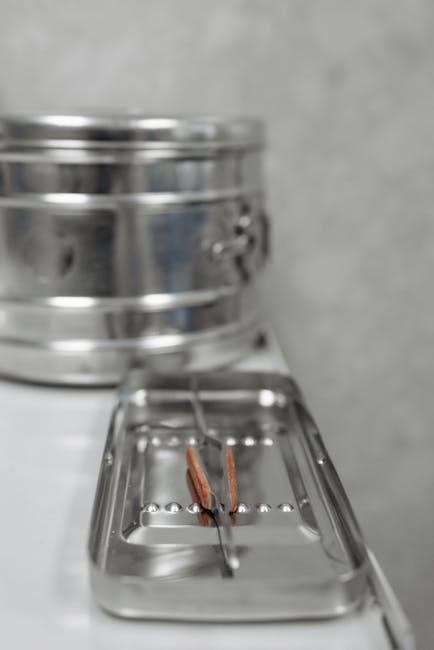Basic surgical instruments are essential tools in surgical procedures, designed to ensure precision, safety, and efficiency․ Understanding their proper use and maintenance is crucial for successful outcomes․

Overview of Surgical Instrumentation
Surgical instrumentation encompasses a wide range of tools designed to perform specific tasks during medical procedures․ These instruments are categorized based on their functions, such as cutting, dissecting, retracting, and suturing․ From scalpels to forceps, each tool is crafted to meet precise surgical needs, ensuring accuracy and efficiency․ The development of surgical instruments has evolved significantly, incorporating advanced materials and ergonomic designs to enhance performance․ Proper understanding and use of these tools are vital for surgeons and medical staff to achieve optimal patient outcomes․ The 54 basic surgical instruments highlighted in various resources provide a foundational toolkit for common procedures, emphasizing the importance of familiarity and skill in their application․ This overview underscores the critical role of instrumentation in modern surgical practices, where precision and reliability are paramount․
Importance of Surgical Instruments in Modern Surgery
Surgical instruments are indispensable in modern surgery, playing a pivotal role in ensuring patient safety and successful outcomes․ Their precision and reliability enable surgeons to perform complex procedures with minimal complications․ The use of these tools is integral to maintaining sterile conditions, controlling bleeding, and accurately dissecting tissues․ Modern surgical instruments, such as those outlined in the 54 basic surgical instruments guide, are designed to meet the highest standards of safety and efficiency․ They also support adherence to surgical checklists, which have been shown to reduce surgery-related deaths by 47%․ By facilitating precise and efficient operations, these instruments are essential for improving patient care and achieving optimal surgical results․ Their importance cannot be overstated, as they directly impact the success and safety of every surgical procedure․
Evolution of Surgical Instruments Over Time
The evolution of surgical instruments reflects advancements in medical knowledge and technology․ Early tools were rudimentary, often improvised from available materials․ Ancient civilizations used bronze and iron instruments, while the Middle Ages saw limited progress․ The Renaissance brought anatomical discoveries, leading to more refined tools․ The 19th century introduced antiseptic practices, prompting designs that reduced infection risks․ Stainless steel became standard in the 20th century, improving durability and sterility․ Modern instruments incorporate advanced materials and ergonomic designs, enhancing precision and comfort․ Technological innovations, such as minimally invasive and robotic-assisted tools, have revolutionized surgery․ These advancements ensure safer, more efficient procedures, aligning with safety protocols like surgical checklists that verify instrument readiness and reduce complications․ The continuous refinement of surgical instruments underscores their critical role in improving patient outcomes and advancing surgical care․

Classification of Surgical Instruments
Surgical instruments are categorized into cutting, dissecting, retracting, suturing, and miscellaneous tools, each designed for specific tasks, ensuring efficiency and precision in surgical procedures․
Cutting Instruments
Cutting instruments are essential in surgery for making precise incisions and dividing tissues․ Common examples include scalpels, surgical knives, and scissors․ These tools are designed for accuracy and control, ensuring minimal tissue damage․ Scalpels, often with interchangeable blades, are used for initial incisions, while surgical scissors, like Metzenbaum or Mayo scissors, are tailored for specific cutting tasks․ The materials used, such as high-carbon stainless steel, ensure durability and resistance to corrosion․ Proper maintenance, including sharpening and sterilization, is crucial to uphold their performance․ Cutting instruments play a vital role in achieving surgical goals efficiently and safely, making them indispensable in every operating room․ Their design and functionality directly impact the success of surgical procedures, emphasizing their importance in modern surgical practice․
Dissecting Instruments
Dissecting instruments are crucial for separating and exposing tissues during surgery, enabling precise access to target areas․ Common examples include forceps, retractors, and elevators․ Forceps, such as Allis or Babcock, are used to grasp and hold tissues, while retractors like Deaver or Richardson retractors expose surgical sites․ Elevators are utilized for lifting tissues or bones gently․ These instruments are typically made from high-quality stainless steel or titanium, ensuring strength and corrosion resistance․ Their ergonomic design reduces fatigue and improves dexterity, allowing surgeons to work with accuracy․ Proper sterilization and maintenance are vital to prevent damage and ensure optimal performance․ Dissecting instruments play a key role in minimizing tissue trauma and enhancing visibility, contributing to successful surgical outcomes․ Their versatility and precision make them indispensable in various surgical specialties, from general surgery to orthopedics and neurosurgery․
Retracting Instruments
Retracting instruments are essential for exposing surgical sites by gently pulling back tissues, muscles, and organs․ They provide optimal visibility, enabling precise dissection and minimizing tissue damage․ Common types include self-retaining retractors like the Weitlaner and Gelpi, which lock in place, and handheld retractors such as the Deaver and Richardson, which require an assistant to hold․ These instruments are typically made of durable materials like stainless steel or titanium, ensuring longevity and resistance to corrosion․ Their ergonomic design reduces surgeon fatigue during prolonged procedures․ Proper sterilization and maintenance are critical to prevent wear and ensure functionality․ Retracting instruments are indispensable in various surgical specialties, from general surgery to orthopedics and neurosurgery, where clear access to the operative field is paramount․ Their effective use enhances surgical efficiency and patient safety, making them a cornerstone of modern surgical practice․
Suturing and Stapling Instruments
Suturing and stapling instruments are vital for closing wounds, joining tissues, and controlling bleeding during surgical procedures․ These tools are designed to ensure precise and secure closure, minimizing complications․ Suturing instruments include needle holders and forceps, which are used to handle sutures and tissue with accuracy․ Stapling instruments, such as surgical staplers, offer a faster alternative, especially in laparoscopic and minimally invasive surgeries․ They are available in various types, including linear, circular, and skin staplers, each suited for specific surgical needs․ Both suturing and stapling instruments are crafted from high-quality materials like stainless steel or titanium for durability․ Their ergonomic design reduces surgeon fatigue and enhances control․ Proper handling and sterilization are essential to maintain their effectiveness and ensure patient safety․ These instruments play a critical role in achieving optimal surgical outcomes and reducing recovery times․ Their precision and reliability make them indispensable in modern surgical practice․
Miscellaneous Instruments
Miscellaneous instruments in surgery include tools that serve specialized or auxiliary functions, complementing other categories․ Examples are suction tubes, irrigation devices, and electrosurgical tools․ These instruments are crucial for maintaining a clear surgical site, managing fluids, and performing precise tissue manipulation․ Suction devices help remove blood and debris, improving visibility, while irrigation tools cleanse the area to prevent infection․ Electrosurgical instruments, like cautery pens, are used for cutting and coagulating tissue․ These tools enhance surgical efficiency and patient safety․ Their versatility allows them to be used across various procedures, from general surgery to specialized fields․ Proper sterilization and handling are essential to ensure their effectiveness․ Miscellaneous instruments often serve as the backbone of surgical setups, supporting primary tools and ensuring smooth operation․ Their role is integral to achieving successful surgical outcomes, making them indispensable in the operating room․ Their design prioritizes functionality and ease of use, catering to diverse surgical needs․

Essential Surgical Instruments
Essential surgical instruments are vital for modern surgery, ensuring precision and patient safety․ They are indispensable in the operating room, supporting surgeons in critical procedures․
Top 10 Most Commonly Used Surgical Instruments
The top 10 most commonly used surgical instruments include scalpels, forceps, retractors, suction tubes, and electrosurgical tools․ These instruments are essential for precision and efficiency in surgical procedures․ Scalpels are used for making incisions, while forceps assist in tissue handling․ Retractors help expose the surgical site, and suction tubes remove fluids․ Electrosurgical tools aid in cutting and coagulating tissues․ These instruments are selected based on their versatility and critical roles in ensuring patient safety and successful outcomes․ Their proper use and maintenance are vital for modern surgical practices, emphasizing their importance in the operating room․ Each instrument plays a unique role, contributing to the overall success of surgical interventions․
Key Characteristics of Basic Surgical Instruments
Basic surgical instruments are designed with specific characteristics to ensure precision, durability, and safety․ They are typically made from high-quality, corrosion-resistant materials like stainless steel or titanium․ Ergonomic design is crucial, allowing surgeons to handle instruments comfortably during prolonged procedures․ Precision engineering ensures sharpness, accuracy, and reliability․ Many instruments feature textured handles for better grip, reducing the risk of slippage․ Some are designed for specific tasks, such as cutting, dissecting, or retracting, while others are versatile for multiple uses․ Durability is a key factor, as instruments must withstand repeated sterilization and use․ These characteristics collectively contribute to successful surgical outcomes, emphasizing the importance of instrument quality in modern surgery․ Proper maintenance and care further enhance their performance, ensuring they remain reliable tools in the operating room․
Role of Each Instrument in Surgical Procedures
Each surgical instrument plays a distinct role in ensuring the success of a procedure․ Scalpels are used for making precise incisions, while forceps and clamps handle tissues and control bleeding․ Retractors expose surgical sites, allowing clear visibility․ Sutures and staplers are essential for closing wounds, promoting healing․ Dissecting instruments separate tissues carefully, minimizing damage․ Cutting tools, like scissors, remove diseased or damaged areas․ Retracting instruments, such as retractors, provide access to deeper tissues․ These specialized tools work together to enable surgeons to perform operations safely and effectively․ Their specific functions ensure that each step of the procedure is executed with precision, reducing risks and improving patient outcomes․ Understanding the role of each instrument is vital for surgeons to achieve optimal results in the operating room․

Surgical Safety and Instrumentation
Surgical safety relies on correct instrument use and checklists, reducing errors and improving patient outcomes․ Proper protocols ensure a safe and efficient surgical environment․
Importance of Surgical Safety Checklists
Surgical safety checklists are critical for ensuring patient safety and reducing complications․ A 19-point checklist, completed in under two minutes, verifies anesthesia, blood supply, and surgical site accuracy, significantly lowering mortality rates by 47%․ These checklists standardize procedures, enhance communication among surgical teams, and minimize errors․ By addressing essential factors like patient identity, medical history, and equipment readiness, they create a safer surgical environment․ Their implementation has been proven to improve adherence to safety protocols and reduce post-operative complications․ Checklists also foster a culture of safety, ensuring that no critical steps are overlooked․ Their widespread adoption has transformed surgical practices, making them a cornerstone of modern surgical safety․ This simple yet effective tool has revolutionized patient care, emphasizing the importance of preparation and precision in surgery․
Impact of Surgical Checklists on Patient Outcomes
The implementation of surgical checklists has significantly improved patient outcomes by reducing mortality rates and complications․ Studies show a 47% reduction in surgery-related deaths attributed to the use of these checklists․ By ensuring adherence to safety protocols, checklists minimize errors such as wrong-site surgery or anesthesia mishaps․ They also improve communication among surgical teams, leading to more consistent and reliable care․ The standardized approach reduces post-operative complications and shortens recovery times․ Patients benefit from a safer surgical environment, with critical steps verified before and during procedures․ This simple tool has proven to be a game-changer, enhancing the quality of care and saving lives․ Its impact underscores the importance of systematic preparation in achieving optimal surgical outcomes․

Role of Instruments in Ensuring Surgical Safety
Surgical instruments play a critical role in ensuring patient safety during procedures․ Properly designed and maintained instruments minimize complications and enhance precision․ Sterilization and regular maintenance of tools prevent infections and ensure reliability․ The use of high-quality instruments reduces the risk of mechanical failure, which could lead to adverse outcomes․ Additionally, instruments designed for specific tasks help surgeons perform operations with greater accuracy, lowering the likelihood of errors․ The careful selection and handling of instruments are essential for maintaining a safe surgical environment․ By adhering to strict standards, surgical teams can rely on their instruments to perform safely and effectively, ultimately protecting patients from potential harm․ The role of instruments in surgical safety cannot be overstated, as they are the cornerstone of successful and complication-free procedures․

Care and Maintenance of Surgical Instruments
Proper cleaning, sterilization, and storage of surgical instruments are vital to ensure their longevity and effectiveness in surgical procedures, maintaining patient safety and operational precision․

Proper Cleaning and Sterilization Techniques
Proper cleaning and sterilization of surgical instruments are critical to prevent infections and ensure patient safety․ Instruments must be pre-cleaned at the surgical site to remove debris, then thoroughly cleaned using ultrasonic cleaners or enzymatic solutions; Sterilization methods include steam sterilization, which is the most common, or ethylene oxide for heat-sensitive instruments․ Instruments should be packaged in sterilization pouches or trays to maintain sterility․ Regular maintenance and quality control checks ensure the effectiveness of sterilization processes․ Adhering to these protocols prevents surgical site infections and extends the lifespan of instruments․ Proper techniques also ensure that instruments remain functional and ready for use in subsequent procedures, maintaining surgical efficiency and reliability․ Cleaning and sterilization are foundational steps in surgical preparation and patient care․
Storage and Handling of Surgical Instruments
Proper storage and handling of surgical instruments are essential to maintain their functionality and longevity․ Instruments should be stored in a clean, dry environment, away from direct sunlight and moisture․ They should be placed in protective cases or trays to prevent damage․ Handling requires care to avoid scratches or bending, especially for delicate instruments․ Regular inspection before and after storage ensures instruments remain in good condition․ Proper organization in storage containers, such as labeled compartments, helps in quick retrieval during procedures․ Instruments should never be stored in a soiled state, as this can lead to corrosion or contamination․ Following these practices ensures instruments remain sterile, functional, and ready for use, contributing to efficient surgical workflows and patient safety․ Proper storage also extends the lifespan of instruments, reducing replacement costs over time․
Preventing Instrument Damage and Wear
Preventing damage and wear to surgical instruments is crucial for maintaining their effectiveness and longevity․ Proper cleaning and sterilization techniques are essential, as residual debris can lead to corrosion․ Instruments should be handled with care to avoid scratches or bending, and staff should be trained in correct handling methods․ Using instruments for their intended purposes prevents misuse, which can cause damage․ Storage in dry, clean environments and protective cases helps prevent rust and accidental damage․ Regular maintenance, such as sharpening and lubricating moving parts, extends instrument lifespan․ Avoiding exposure to extreme temperatures or harsh chemicals is also important․ By following these practices, surgical instruments remain in optimal condition, reducing the need for frequent replacements and ensuring reliable performance during procedures․ Proper care not only preserves the instruments but also contributes to patient safety and surgical success․ Regular inspections can identify wear early, preventing potential complications․
Advanced Topics in Surgical Instrumentation
Technological advancements in surgical instruments enhance precision and patient safety, with innovations like robotic-assisted tools and smart devices improving outcomes, as seen in checklist-driven safety protocols reducing complications․

Future Trends in Surgical Instrument Design
Future trends in surgical instrument design emphasize enhanced ergonomics, miniaturization, and integration of smart technology․ Instruments are being developed with advanced materials for durability and precision․ The rise of robotic-assisted surgery is driving innovation, with tools designed for minimally invasive procedures․ Additionally, there is a growing focus on sustainability, with eco-friendly materials being explored․ Safety features, such as automated checks and real-time feedback, are becoming integral to instrument design․ These advancements aim to improve surgical outcomes, reduce complications, and streamline procedures․ The evolution of surgical instruments is expected to revolutionize healthcare, making surgeries safer and more efficient․ As technology progresses, the future of surgical instrumentation holds promise for groundbreaking improvements in patient care․

Role of Technology in Modern Surgical Instruments
Technology plays a pivotal role in modern surgical instruments, enhancing precision, safety, and efficiency․ Advanced materials and ergonomic designs improve usability, while smart instruments integrate sensors for real-time data․ Robotics and AI are transforming tools, enabling minimally invasive surgeries with greater accuracy․ Automation in instruments, such as self-retaining retractors, streamlines procedures․ Data connectivity allows for better monitoring and decision-making․ These innovations reduce human error, improve patient outcomes, and set new standards in surgical care․ The integration of technology ensures that modern instruments meet the demands of complex procedures, making surgery safer and more effective․ As tech evolves, so do the capabilities of surgical instruments, driving progress in healthcare․
Economic Impact of Surgical Instrumentation
The economic impact of surgical instrumentation is significant, influencing healthcare costs, hospital budgets, and global markets․ High-quality instruments are costly to purchase and maintain, contributing to overall surgical expenses․ The development and acquisition of advanced tools drive up initial investment, while recurring costs for sterilization and replacement add to the financial burden․ However, these investments improve patient outcomes and reduce long-term healthcare costs by minimizing complications․ The global market for surgical instruments continues to grow, driven by demand for precision and safety․ Economic factors also influence the adoption of new technologies, as hospitals balance budget constraints with the need for modern equipment․ The economic implications of surgical instrumentation highlight the importance of cost-effective solutions without compromising patient care․
Surgical instruments are vital in modern surgery, ensuring precision and safety․ Their evolution reflects advancements in medical technology, emphasizing their critical role in patient care and outcomes․
Surgical instruments are fundamental to modern surgery, enabling precise and safe procedures․ They are classified into cutting, dissecting, retracting, suturing, and miscellaneous tools, each serving specific functions․ Essential instruments like scalpels, forceps, and retractors are indispensable in daily surgical practices․ The use of surgical safety checklists has significantly reduced complications, with a 47% decrease in surgery-related deaths․ These checklists ensure anesthesia verification, blood supply checks, and site confirmation, among other critical steps․ Proper care, including sterilization and storage, extends instrument longevity and maintains surgical safety․ Understanding these elements highlights the vital role of surgical instruments in improving patient outcomes and advancing medical practice․
Final Thoughts on the Importance of Surgical Instruments
Surgical instruments are indispensable in modern medicine, enabling surgeons to perform life-saving procedures with precision and safety․ Their evolution reflects advancements in medical technology, from basic tools to specialized devices․ The 54 basic surgical instruments outlined in various resources form the backbone of surgical practices, ensuring efficiency and reliability․ The integration of safety checklists has further enhanced surgical outcomes, reducing complications and mortality rates by 47%․ As technology advances, future instruments will likely incorporate smarter designs and materials, improving ergonomics and functionality․ Investing in high-quality instruments and their proper maintenance is crucial for healthcare systems worldwide․ Ultimately, surgical instruments are not just tools but vital partners in the pursuit of saving lives and improving patient care․
